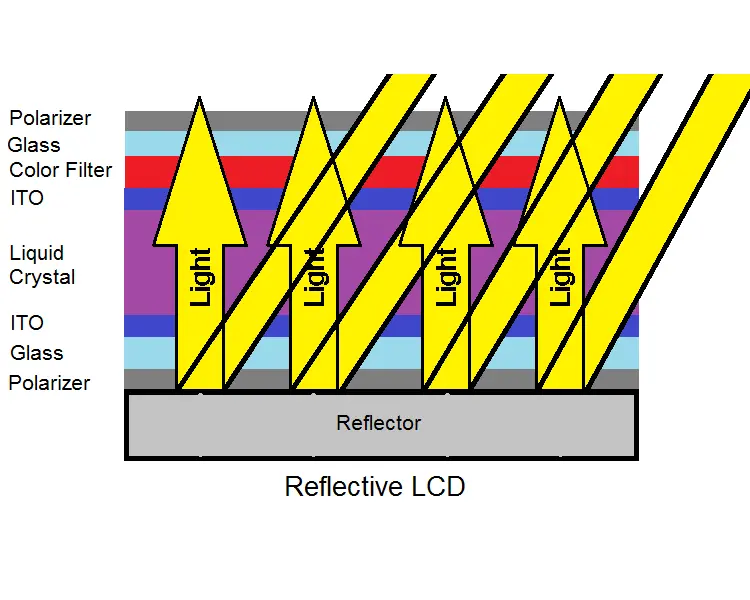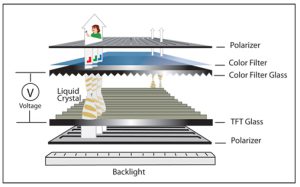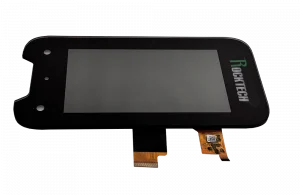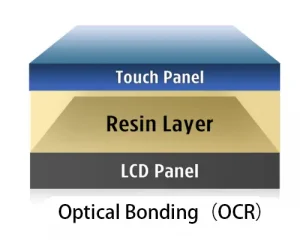A reflective LCD display is a unique type of liquid crystal display that does not rely on a traditional backlight. Instead, it uses ambient light — natural sunlight or surrounding illumination — to reflect light back through the display layer. This approach significantly reduces power consumption, making reflective LCDs ideal for portable, battery-powered, or energy-constrained applications.
Unlike standard transmissive displays that consume considerable power to maintain visibility, especially outdoors, reflective LCDs thrive in bright lighting conditions. With no backlight to power, these displays offer excellent energy efficiency, good visibility in daylight, and a longer operational life in embedded systems. Whether used in a reflective LCD monitor or as part of an IoT control interface, this technology provides clarity without compromise.
How Reflective LCDs Work
A reflective LCD functions by placing a mirror-like layer behind the liquid crystal matrix. When ambient light strikes the screen, it passes through the polarizer and the liquid crystals, hits the reflective layer, and is then bounced back to the viewer. The arrangement of liquid crystals controls how much light is reflected from each pixel, forming images or text.
The key to its effectiveness lies in the simplicity of the structure. By removing the backlight, reflective LCDs eliminate a major source of power drain, making them especially useful for displays that need to operate continuously on limited battery power. Additionally, they tend to emit less heat and are easier to integrate into compact designs.
Advantages Over Transmissive and Transflective Displays
Compared to transmissive LCDs — which struggle with glare and visibility under direct sunlight — reflective LCDs shine in outdoor or high-light settings. They not only perform better under such conditions but also consume a fraction of the energy. Unlike transflective displays that combine both transmissive and reflective elements (and often involve trade-offs), fully reflective LCDs are optimized solely for brightness-rich environments.
Some notable benefits include:
- Superior visibility in sunlight and brightly lit environments
- Minimal power draw due to the absence of a backlight
- Lower overall system temperature and improved reliability
- Enhanced battery life for portable or off-grid devices
| Feature | Reflective LCD | Transflective LCD | Transmissive LCD |
|---|---|---|---|
| Backlight | Not required | Optional (used in dark) | Always required |
| Readability in Sunlight | Excellent | Good | Poor |
| Power Consumption | Very low | Moderate | High |
| Color Support | Limited (often monochrome) | Available (less vibrant) | Full color with high brightness |
| Usage Environment | Outdoor, bright ambient light | Mixed lighting conditions | Indoor or low-light environments |
| Cost | Low | Medium | Higher |
| Applications | Smartwatches, e-readers, outdoor meters | Industrial devices, medical monitors | Smartphones, tablets, TVs |
Applications in Embedded and Industrial Systems
Reflective LCDs are commonly found in devices where low power and daylight readability are priorities. They are a popular choice for handheld instruments, outdoor meters, and industrial interfaces that must perform reliably in bright environments.
Use cases include:
- Handheld testers and diagnostic equipment
- Solar-powered IoT control panels
- Wearable fitness trackers and outdoor navigation devices
- Reflective LCD monitors in off-grid applications
- Medical devices used under bright clinical lighting
In many of these applications, the integration of a reflective LCD helps manufacturers meet both functional and environmental efficiency goals — particularly in industries focused on energy conservation and rugged reliability.
Limitations to Be Aware Of
While the benefits are clear, reflective LCDs are not suitable for every use case. In dim or low-light environments, the lack of a backlight can make these displays difficult to read unless paired with a front light or auxiliary lighting. As such, they’re often not recommended for night-time use or environments with inconsistent lighting.
Additionally, the color range and contrast ratio of reflective LCDs can be more limited compared to backlit alternatives. For applications requiring vivid color reproduction or complex graphics, other display technologies like IPS LCDs or OLEDs may be more appropriate.
Future Outlook and Industry Trends
As device manufacturers continue to seek low-power and sunlight-readable display options, the role of reflective LCD technology is expected to grow — particularly in energy-efficient and green tech sectors. With increasing demand from wearable devices, smart agriculture sensors, and outdoor medical monitoring tools, reflective LCD displays offer a compelling blend of efficiency and clarity.
Recent advancements have improved reflectivity rates and even brought limited color support into some reflective display designs, further expanding their potential. When combined with low-power embedded processors or solar-based designs, reflective LCDs open new paths for sustainable product development.
Conclusion
A reflective LCD display may not be the flashiest screen on the market, but its value in energy-sensitive, sunlit environments is unmatched. By harnessing ambient light instead of fighting against it, this display technology delivers both functional performance and operational efficiency.
Whether you are designing a low-power embedded controller or building the next generation of outdoor devices, a reflective LCD monitor could be exactly what your project needs. Consider the trade-offs, evaluate your lighting environment, and choose a solution that aligns with your product’s purpose — and its power budget.





